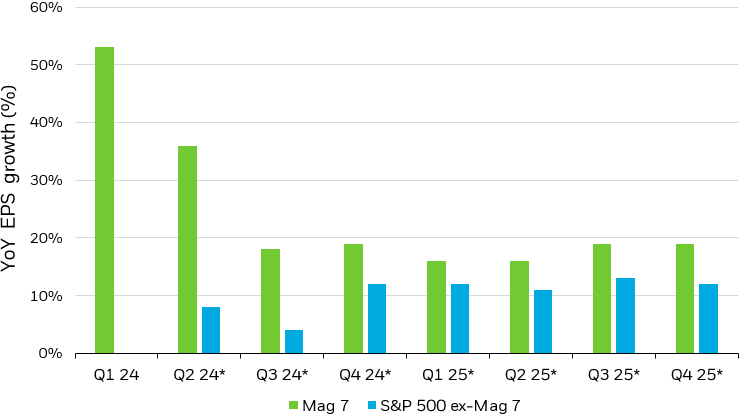As we head into the fourth quarter, the U.S. economy looks strong, but shows signs of potential slowing.
But we think any near-term volatility can create opportunities for investors.
Hi, I’m Kristy Akullian, Head of iShares Investment Strategy at BlackRock. Our 2024 Fall Investment Directions aims to provide investors with a roadmap for the remainder of the year.
Here are three key takeaways:
First, we believe the start of the Fed’s easing cycle is the time to consider moving out of cash and taking advantage of higher rates before they meaningfully drop.
Second, we think this is a moment for equity investors to position for a broadening out as tech earnings slow and other sectors accelerate. Quality may still be key however.
Third, we believe the belly of the yield curve currently represents the most compelling option as a source of both income and diversification — especially if growth softens from here.
Indeed, the U.S. economy has been resilient but shows signs of slowing since we published our Midyear Investment Directions in June.
Reflecting the cooling economy — and inflation approaching its 2% target — the Federal Reserve cut rates by 50 basis points in September.
We expect additional rate cuts this year, but in our view of the market, it is pricing in more easing than the Fed will actually deliver.
This divergence as well as uncertainty stemming from the U.S. election, could drive volatility. Add to that, September and October are historically tough months for stocks, a seasonal pattern that is only exaggerated in election years.
For investors looking to reduce volatility in their portfolios, we see opportunity in the tactical use of buffered strategies and minimum volatility funds. But, we also believe that near-term pull back represent an opportunity to allocate to high quality companies trading at reasonable valuations. We think investors should consider reallocating from mega cap to large cap, not from large cap to small or mid. It also presents an opportunity to more evenly balance between growth and value styles.
Lastly, we’re looking at sectors with value tilts like financials and defensive tilts like utilities.
Still, the next few months could be volatile and ETFs can be an effective tool to help mitigate volatility through diversification. While active management provides a way to quickly adjust exposures in an environment of greater uncertainty.
Thanks for watching and be sure to check out our full Fall 2024 Investment Directions on iShares.com.
Disclosures:
Source: Historical price and volatility analysis during September and October and during election years from BlackRock, Bloomberg, as of September 16, 2024. Historical analysis based on monthly returns of the S&P 500 Index back to index inception. Volatility as measured by the Chicago Board Options Exchange Volatility Index. Indexes are unmanaged and one cannot invest directly in an index. Past performance does not guarantee future results.
Past performance does not guarantee future results.
This material is not intended to be relied upon as a forecast, research or investment advice, and is not a recommendation, offer or solicitation to b or sell any securities or to adopt any investment strategy. The opinions expressed are as of the date indicated and may change as subsequent conditions vary. The information and opinions contained in this material are derived from proprietary and nonproprietary sources deemed by BlackRock to be reliable, are not necessarily all-inclusive and are not guaranteed as to accuracy. As such, no warranty of accuracy or reliability is given and no responsibility arising in any other way for errors and omissions (including responsibility to any person by reason of negligence) is accepted by BlackRock, its officers, employees or agents. This material may contain “forward-looking" information that is not purely historical in nature. Such information may include, among other things, projections and forecasts. There is no guarantee that any of these views will come to pass. Reliance upon information in this material is at the sole discretion of the viewer.
This material contains general information only and does not take into account an individual's financial circumstances. This information should not be relied upon as a primary basis for an investment decision. Rather, an assessment should be made as to whether the information is appropriate in individual circumstances and consideration should be given to talking to a financial professional before making an investment decision. This material does not constitute any specific legal, tax or accounting advice. Please consult with qualified professionals for this type of advice.
Prepared by BlackRock Investments, LLC, member FINRA
©2024 BlackRock, Inc or its affiliates. All rights reserved. iSHARES and BLACKROCK are trademarks of BlackRock, Inc. or its affiliates. All other marks are the property of their respective owners.
iCRMH0924U/S-3885434










